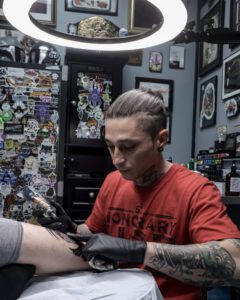Getting a tattoo is an individual experience, but one thing is certain – there will be some degree of discomfort. What is the cost? It all depends on the location of your tattoo, the size of the design, and how much pain you can handle. If you’re curious about the level of pain associated with tattoos and which areas are the most (or least) sensitive, we have all the information you need. This manual will lead you through all the information regarding tattoo pain, covering the most sensitive areas and providing expert advice on pain management. Whether it’s your first tattoo or your fifth, it’s important to be aware of what to expect.
 Exploring Tattoo Pain: Understanding Why Some Areas Are More Painful to Tattoo
Exploring Tattoo Pain: Understanding Why Some Areas Are More Painful to Tattoo
During a tattoo procedure, needles pierce the epidermis (the outer layer of skin) and inject ink into the dermis (the second layer). Although it may seem easy, your body responds to the needle in various ways, causing feelings of pain.
Nerve endings and the perception of pain sensitivity
The level of pain you experience is mainly determined by how many nerve endings are present in that specific area. Regions of the body that have a greater number of nerves tend to be more responsive to the process of getting a tattoo. For example, areas with high nerve endings like ribs and spine are more sensitive to tattooing, unlike places like upper arm or thighs, which have less nerves and more muscle.
Bone Proximity
The proximity of the tattoo to your bones is also a major factor in the level of pain experienced. Skin that is taut over bone such as at the wrists, ribs, or ankles, is more painful because there is less fat and muscle to soften the needle’s pressure. Conversely, regions with increased padding (such as thighs or upper arms) generally experience lower levels of pain.
Comparison between Fat and Muscle Zones
Muscle and fat provide additional padding during the tattooing process. Having tattoos on parts such as the outer shoulder, calf, or thigh may cause less pain because there is more tissue separating the needle from the bone. On the other hand, less fatty, bony regions such as your collarbone, ribcage, or spine offer minimal protection, making the pain more intense.
Breakdown of the Most Painful Tattoo Areas by Body Part.
Although each tattoo experience is unique to the individual, there are certain widely recognized “painful spots” that are universally acknowledged by most people. When getting a tattoo in these locations, be prepared for additional pain.
- Ribs – Numerous individuals claim that receiving a tattoo on the ribs is one of the most excruciating experiences they have ever had. Rib tattoos are particularly painful due to the thinness of the skin, the extensive bone surface, and the continuous movement of your ribcage while breathing. The discomfort is usually severe and piercing.
- Spine – Getting a tattoo on your spine can be extremely painful. The spinal column is very delicate because it is located close to the nervous system. Due to the thin skin and proximity of bones to the surface, anticipate experiencing marked discomfort.
- Feet and Ankles – There is minimal padding between the skin and bone in the feet and ankles due to a lack of fat. When placed in this region, tattoos may produce intense, fiery feelings due to the abundance of nerve endings, which can endure for the entire duration of the session.
- Hands and Fingers – Getting a tattoo on your hands and fingers hurts due to the numerous nerve endings found in these regions. Moreover, the skin is delicate and the hands are always moving, making it a challenging and sensitive location for tattooing.
- Inner Arm/Elbow Ditch – The sensitive nerves make the skin inside your arm and around the elbow extremely delicate. Getting a tattoo in this region may cause a significant amount of discomfort, as the needle passes over the skin, resulting in a burning or sharp sensation.
- Head and Face – Both the head and face are delicate regions, sensitive to both pain and nerve impact. The presence of numerous nerve endings and the absence of fatty tissue result in these areas being some of the most painful to tattoo. Facial tattoos, particularly those around the jaw or forehead, are known for causing extreme discomfort.
Least Painful Tattoo Areas: Easiest Spots for First-Timers
If you’re a beginner getting a tattoo and looking to lessen the pain, think about targeting these areas that are generally more tolerable for most individuals.
- Upper Arm – The upper arm is frequently chosen by individuals getting their first tattoo. The region is adequately padded with muscle and fat, which aids in decreasing discomfort. The sensation experienced by most individuals in this area is often described as slight discomfort, similar to a persistent itching sensation.
- Thighs – Getting a tattoo on the outer thigh is often perceived as less painful compared to other body parts. There is an abundance of muscle and fat to cushion the needle’s pressure, making it a sizable, smooth surface for tattoo artists to tattoo on.
- Calves – Similar to the thigh, the calf muscle offers plenty of padding, making getting tattoos in this location more tolerable. The discomfort is usually mild to moderate, making it an ideal option for a bigger tattoo.
- Outer Shoulder – Getting a tattoo on the outer shoulder is also a good choice to minimize pain. It is located away from delicate parts like the spine or ribs and has abundant muscle and fat. The majority of individuals consider the pain in this area to be less significant when compared to more delicate areas.

Pain Management During and After a Tattoo
While you can’t entirely avoid tattoo pain, there are ways to manage it both during and after your session.
Mental Preparation
Prepare yourself mentally before getting a tattoo. Anticipate some discomfort, but understand that it can be controlled. A lot of individuals believe that the expectation is frequently more unpleasant than the physical discomfort.
Applying numbing creams
Using numbing creams can be a way to alleviate pain, particularly when getting a tattoo in a sensitive location or enduring a lengthy session. Certain studies indicate that specific numbing agents may be successful, but their effectiveness and outcomes depend on the individual and the tattooist.
Tips for post-treatment care in order to reduce discomfort.
Adequate post-tattoo care is essential in reducing discomfort after getting a tattoo. By using the right products, such as Skin Reserve, and maintaining cleanliness and moisture, you can lower the risk of infection and alleviate discomfort during the tattoo healing process.
Healing pain associated with tattoos
It’s crucial to keep in mind that the pain may not cease upon exiting the studio. The duration of healing pain after getting a tattoo varies, ranging from a few days to a few weeks, based on the size and placement of the tattoo. To prevent any complications, refrain from scratching or touching the affected area and make sure to adhere to the provided aftercare guidelines for a successful recovery.
Factors That Affect Tattoo Pain
Multiple variables can impact the level of pain felt when getting a tattoo.
Size of Tattoo
Greater tattoos typically result in increased discomfort due to the extended duration required for their completion. Continued contact with the needle can result in heightened discomfort, particularly in sensitive regions.
Style of tattooing
The kind of tattoo you choose can impact how much pain you feel. Delicate lines are usually less uncomfortable compared to dark shading or dense color work, which involves additional time and pressure on the skin.
Tattoo Artist’s Method
Certain artists have a gentle touch, whereas others may exert more force while tattooing. Discovering a proficient artist who is knowledgeable in your preferred style can greatly impact the level of discomfort you undergo.
Individual’s capacity to endure pain
Everyone has a unique tolerance for pain. Certain individuals have a higher sensitivity to pain, while others may hardly react during a tattoo appointment. Understanding your body and discussing your comfort levels with your tattoo artist is crucial.
Tattoo Pain FAQs
- Which part of the body hurts the most when getting tattooed?
The ribs, spine, and feet are generally considered the most painful spots due to thin skin and proximity to bone.
- Can I take painkillers before getting a tattoo?
It’s best to avoid painkillers like aspirin, as they thin the blood. However, ibuprofen may be an option after consulting with your artist.
- Do tattoo-numbing creams really work?
Numbing creams can help reduce discomfort, especially for longer sessions, but their effectiveness varies by individual and product.
- How long does tattoo pain last after the session?
The most intense pain usually goes away after the session is complete. Soreness, however, can last for a few hours to a day. Sensitivity can also persist for a few days to a week as the tattoo heals.
- What can I do to manage pain during long tattoo sessions?
Staying hydrated, taking breaks, and practicing deep breathing can help you manage pain during extended tattoo sessions.
- Is it normal for tattoos to hurt during healing?
Yes, some discomfort is common during healing, especially if the tattoo is in a spot that moves frequently or rubs against clothing.
- Can I build a tolerance for tattoo pain?
While you might get used to the sensation after multiple tattoos, everyone’s pain threshold is different. Some people find it easier over time, while others may still experience discomfort.
Deciding on the perfect location for your upcoming tattoo
By the close of the day, each tattoo involves a certain amount of discomfort, yet being aware of what to anticipate can assist you in choosing the best location for your tattoo. If you have worries about pain, have a discussion with your tattoo artist as they can offer customized guidance depending on your design and where it will be placed. Wherever you choose to receive your tattoo, the outcome will be worthwhile!
Also, when thinking of the perfect location, any ATS will work! 😉
